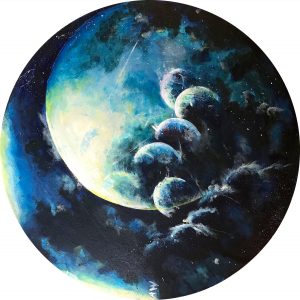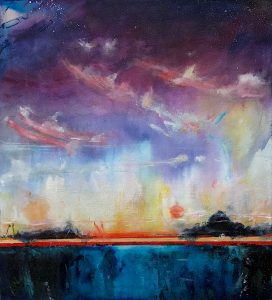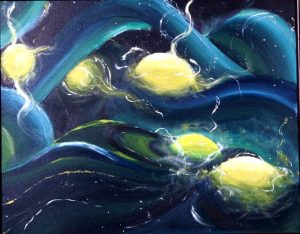 DAU—Amy Williams, thank you for sitting down to talk to me.
DAU—Amy Williams, thank you for sitting down to talk to me.
AW—That’s OK
DAU—Talk to me about your philosophy of art.
AW—My philosophy. I think you have to follow your vision. Art is selling a feeling. Visual art either touches the viscera or it doesn’t.
DAU—so who are your favorite artists?
AW—Oh I don’t know. I am still thinking about the emotional cost. As a viewer, If you want to buy a work, it’s because it touches you, eases your pain or inspires.
DAU—What about people who buy work to match their décor?
AW—Basquiat threw people out of his studio for that.
DAU—but some pictures are pretty, you want them because they are pretty. Turner landscapes, Degas horses.
AW—But from the artists point of view they were emotional. I like Cy Twombly. His works are beautiful. But he was in this element where each mark he made was an experience. His works have a spiritual element that reflect a connection to something larger than himself.
 DAU—Are you the only artist in your family?
DAU—Are you the only artist in your family?
AW—My brother draws. My mom is creative. She did a picture once that my brother took to school and got a good grade on.
DAU—Wow! Did your mom know?
AW—I don’t know. I don’t remember.
DAU—Are you from a large family?
AW—yes, 3 brother and two sisters. I am right in the middle, the oldest girl.
DAU—and do they support your being an artist?
AW—They are. Although they worry. Very protective of the girls. I wanted to go to Europe to study, and they didn’t want me to. They have not always been on board with the whole artist experience. It wasn’t the art. It was all the other stuff.
DAU—When did you know you were an artist?
AW—I think I always wanted to be an artist. I remember being 6 or 7 years old and watching my brother draw and wanting to do that. Art is always calling me. There are so many distractions. I let things sidetrack me. I don’t recognize the diversions—I get caught up in stuff and then…well, art is always calling me. Some people describe it as a sickness.
DAU—What will it take to let it claim you? Or to claim it?
AW—I can’t answer that. It’s the thing we all struggle with, balancing doing the thing we need to do and the thing we want to do.
DAU—Is art the thing you need or the thing you want?
AW—oh, both, I guess, at different times. I tried to turn it to something else. I tried graphic design.
DAU—so you went to school for graphic design?
AW—well not at first. I started classes at Sinclair. I had a great teacher there. Curtis Barnes—he really pushed my boundaries. He made me look at the spaces in a painting as well as the color. There was this painting in green and yellow inspired by a book jacket. It made me want to paint. I think it was called Venus Rising. My favorite works are the ones that come from that connection—now that I think about it, I spend a lot of time thinking about that spiritual element. Even when I am not painting.
DAU—and graphic design?
AW—It was just a thing I tried. I always come back to art. I got a bachelor’s degree in fine arts at Miami. I had good teachers there. Dana Saulnier. Very intuitive artist. Big huge abstracts, but with deeper meaning, very expressive of grief and loss.
DAU—so you went to school in Dayton and then Miami, are you from Dayton?
AW—Dad retired from the air force here in the late 70’s. I lived in Huber Heights. When I started at school I came into Dayton. It’s not a big town, but it felt so different from Huber Heights. At first, I felt like I didn’t know people, I missed neighbors and connections. But you start to know people. You live here, and you get a sense of community. I think Dayton gets a bad rap from the surrounding areas—I think you live outside it, and you drive through it, you don’t see how connected it is. We watch out for each other. We are a community.
DAU—And now you have Wholly Grounds, and you’re a big part of the community.
AW—Thanks for saying that. The coffeehouse was a compromise with my partner—he wanted to open a bar. So, we opened a coffeehouse with a liquor license.
DAU—I think it’s wonderful. Thank you for all you do to support Artists United. Its great to have to gatherings here, and to see the local art on the walls, and you have live music. It’s very welcoming.
AW—And that’s what I want. I want people to come here and feel inspired. I want to be a part of the neighborhood.
DAU—Are you South Park or Oregon?
AW—We’re South Park, on this side of the highway. But I love the Oregon district. There are so many things I like about Dayton. My neighborhood is one of them. Riverscape. The festivals! I really love the reggae festival. And the Lebanese festival. And the Blues Festival.
DAU—so, all these festivals–is it the music or the food ?
AW—the belly dancers.
DAU—I forgot the belly dancers.
Since our interview, Covid-19 shelter-at-home orders have stopped Artists United from meeting at Wholly Grounds, but they are open for carry-out. Amy and her partner Tony are grateful for the community support they’ve received during this shut down and look forward to having artists back in house.